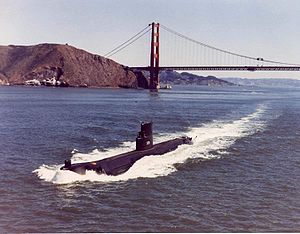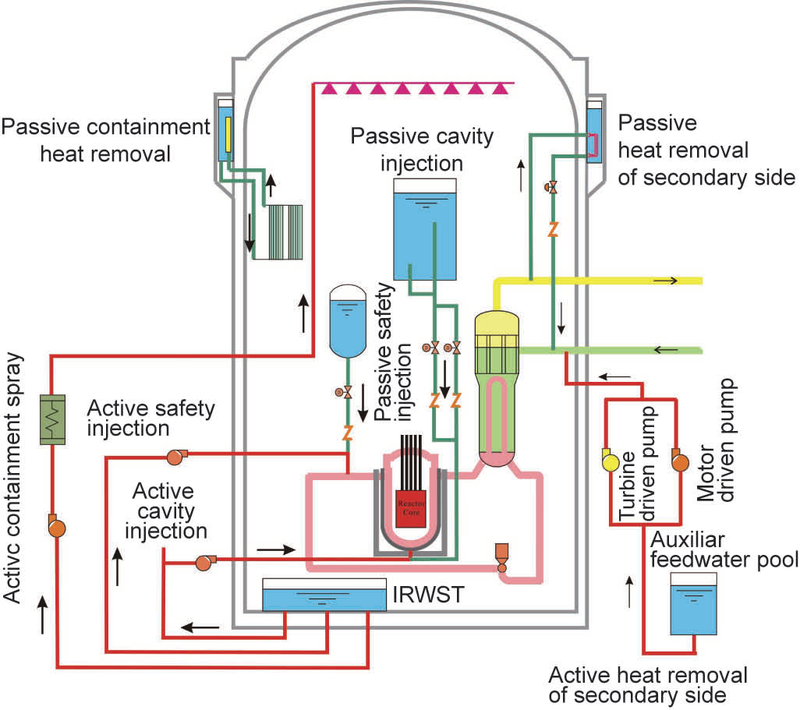Part 1 of 2 Parts
I have blogged about nuclear submarines in the arsenals of nuclear-armed nations before. The Chinese, Russians, U.K, France, the U.S., Pakistan and India all have nuclear submarines that can launch nuclear-tipped missiles. These constitute a leg of what is called the nuclear triad. The other two legs are nuclear bombers and ICBM with nuclear warheads. The nuclear submarines are seen as providing the ultimate retaliation capability if the other two legs of the nuclear triad have been destroyed by an enemy. Today, I am going to talk about the most advanced nuclear submarine possessed by the U.S. Navy.
By the late 1950s, the Soviet navy had nuclear powered submarines that could reach twice the maximum depth of most of the U.S. subs. Often the Soviet subs had a higher maximum speed. However, despite these advantages, they had a very significant disadvantage against U.S. subs. The Soviet subs were a lot noisier.
U.S. subs were able to easily detect and trail Soviet subs from a distance that made the U.S. subs undetectable by the Soviet subs. However, by the 1980s, the Soviets were improving their acoustic stealth technology. The Soviet Navy had acquired propeller-milling technology from Toshiba and Kongsberg companies. This allowed the Soviets to create a much quieter seven bladed propeller on their new Akula-class subs.
The Pentagon concluded that the Akula-class subs had superior specification to most of the Los Angles-class subs that constituted the majority of operational U.S. subs. In 1983, the U.S. began development of the biggest, fastest, and quietest attack submarine they could imagine to regain U.S. superiority over Soviet Subs.
The construction of the U.S.S. Seawolf began at Electric Boats in October of 1989. It would be about three hundred and fifty feet long which is more than a football field and displace over nine thousand tons when submerged. The Los Angeles-class subs carried thirty seven torpedoes in four tubes. The Seawolf was armed with fifty heavy-weight 533-millimeter Mark 48 torpedoes or Harpoon anti-ship missiles. These could be launched from eight extra-large 660 mm torpedo tubes. Surface-attack Tomahawk missiles could also be launched from these tubes.
The Seawolf-class of subs is made of a special high strength steel called HY-100. Its conning tower is reinforced so it can cope with operations in Arctic Ice. The S6W pressurized water reactor gives the Seawolf-class an incredible forty miles per hour top speed that allow it to chase down any sub currently in the arsenal of any other country.
The most important advanced technology incorporated in the Seawolf-class involved acoustic stealth. The Seawolf-class generates one tenth of the noise of the quietest Los Angeles-class subs. The Seawolf-class generates about ninety-five decibels in the ocean where the background noise is ninety decibels.
In addition, the Seawolf-class utilizes a jet propulsion pump system instead of the standard propellers that powered the Los Angeles-class. This means that the Seawolf-class can maintain its super quiet operation even traveling at twenty-three miles per hour which is much faster than other subs could travel while remaining in stealth mode.
The Seawolf-class has a twenty-four-foot diameter spherical sonar array on its bow. It also has wide-aperture flank arrays and can tow TB-16D and TB-29 sonar arrays. The information gained by these sensors is fed to the BSY-2 combat system on the Seawolf-class. The Seawolf-class can engage multiple targets simultaneously with their Mark 48 torpedoes. The Mark 48 can be guided by wire from the sub or with their own sonar.
Please read Part 2 next
Blog
-

Nuclear Weapons 378 – The Seawolf-class Is The Most Advanced Nuclear Submarine In the U.S. Arsenal – Part 1 of 2 Parts
-

Geiger Readings for Apr 16, 2019
Ambient office = 80 nanosieverts per hour
Ambient outside = 117 nanosieverts per hour
Soil exposed to rain water = 116 nanosieverts per hour
Bartlett pear from Central Market = 66 nanosieverts per hour
Tap water = 134 nanosieverts per hour
Filter water = 124 nanosieverts per hour
-

Nuclear Reactors 672 – China Has Decided To Use Their Own Hualong One Reactor Design To Expand Their Nuclear Reactor Fleet
China has been a strong proponent of nuclear power. They have announced ambitious programs to build and operate many new nuclear power reactors to feed their growing economy with the electricity it needs. However, the 2011 Fukushima disaster had a serious impact on their ambitious building program. Now after a few years of scaled back activities, the Chinese are again moving forward with plans for the construction of many new reactors.
For a long time, foreign manufacturers of nuclear power reactors saw China as a great place to build their new designs for display to potential buyers. Chinese plans included their intention to build new reactors based on designs from France, the U.S. and Canada.
In 2006, China and the U.S. signed a technology transfer agreement that made the new Westinghouse AP1000 nuclear power reactor the design of choice for China’s nuclear ambitions. China also announced that advanced third generation technology would be used as a result of safety reviews carried out after the Fukushima disaster.
By the time that the AP1000 and the EPR reactors were finished and ready to be brought online in China after schedule delays and cost overruns, the new Chinese Hualong One home-grown reactor design appears to be as viable as those foreign designs. China has not yet completed its first Hualong One reactor but they express great confidence that it will not suffer construction delays and will be able to compete with foreign designs on cost and safety.
China has decided to construct a Hualong One as its first new reactor project in almost three years. Construction will begin at a site in Zhangzhou later this year. The Zhangzhou site was originally going to host an AP1000 reactor.
Li Ning is a nuclear scientist and dean of the College of Energy at Xiamen University. He said, “The problem with AP1000 – the delays, the design changes, the supply chain issues and then the trade problems – has forced their hand, and it has become Hualong.” He also remarked that the licensing procedures in China would be a big advantage for the Hualong One. He said, “For the Hualong, there are four reactors already under construction and one of them is near completion already. It is a Chinese design so it wouldn’t be very hard to license the next four.”
EDF, the state-run utility in France, assisted in the construction of the EPR project in Guangdong province. They have declined to comment on the change in China’s nuclear design choice. Westinghouse, which has undergone bankruptcy since the technology transfer deal was inked, also did not respond with respect to Chinese plans.
China has not just selected the Hualong One design for domestic use. They also have serious ambitions to sell Hualong Ones to foreign customers. Currently, the Chinse are constructing a Hualong One project in Pakistan, The Hualong One is also a contender for nuclear projects in Argentina and Britain.
Li Xioming is the assistant general manager of the state ownded China National Nuclear Corporation. (CNNC). He recently said, “The technologies are now just about the same as those of the United States, France and Russia. This is the foundation that we will rely on for our future survival and our international competitiveness.”
“China has already become one of the small number of countries that has independently mastered third-generation nuclear power technology, and it has the conditions and comparative advantages to scale up and go into mass production,” he said at an industry conference. -

Geiger Readings for Apr 15, 2019
Ambient office = 79 nanosieverts per hour
Ambient outside = 112 nanosieverts per hour
Soil exposed to rain water = 109 nanosieverts per hour
Crimini mushroom from Central Market = 108 nanosieverts per hour
Tap water = 86 nanosieverts per hour
Filter water = 80 nanosieverts per hour
-

Geiger Readings for Apr 14, 2019
Ambient office = 92 nanosieverts per hour
Ambient outside = 86 nanosieverts per hour
Soil exposed to rain water = 86 nanosieverts per hour
Carrot from Central Market = 110 nanosieverts per hour
Tap water = 79 nanosieverts per hour
Filter water = 71 nanosieverts per hour
-

Geiger Readings for Apr 13, 2019
Ambient office = 91 nanosieverts per hour
Ambient outside = 131 nanosieverts per hour
Soil exposed to rain water = 133 nanosieverts per hour
Broccoli from Central Market = 86 nanosieverts per hour
Tap water = 100 nanosieverts per hour
Filter water = 86 nanosieverts per hour
Dover sole – Caught in USA = 119 nanosieverts per hour
